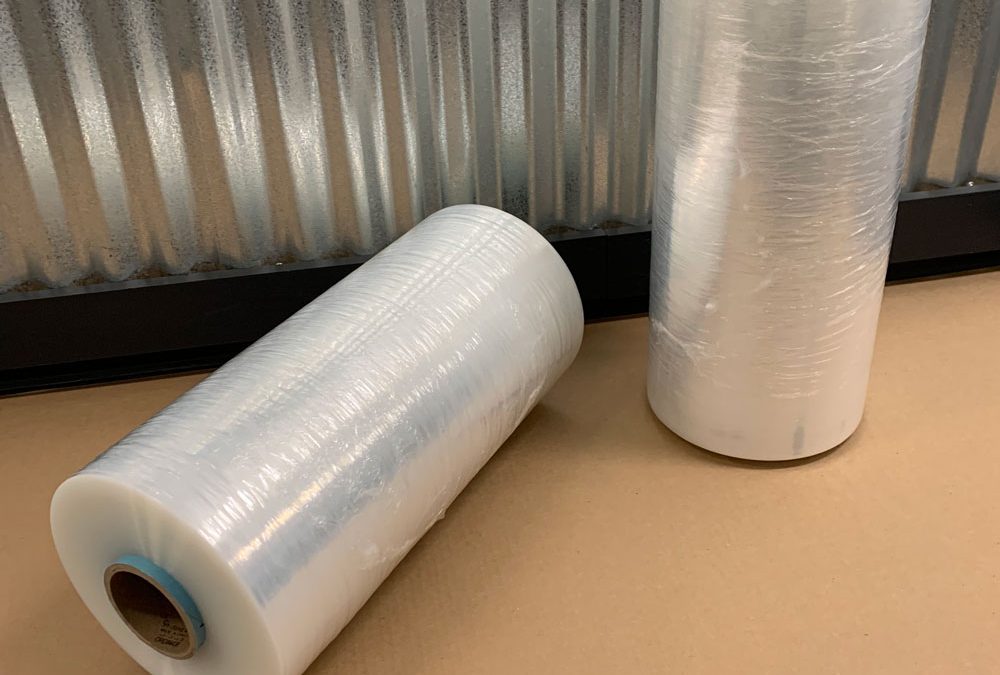The use of pallets can mean the difference between moving one box or as many as two hundred. Actually transporting filled pallets requires stretch wrap—the elastic film that’s wrapped around the entire parcel, to secure goods to the pallet. This is done for a number of reasons.
Why stretch wrapping is essential
Stretch film is used to wrap palletized goods to help reduce product loss and worker injury, as well as to discourage load tampering. The material is most commonly made from linear low-density polyethylene (LLDPE), in a variety of thicknesses, widths, and types of stretch wrap. Although the elastic recovery keeps items secured to one another and the pallet, there are different kinds of stretch film to accommodate different types of loads with enhanced durability, elasticity, and clarity.
Cast stretch wrap
This stretch film is manufactured using a cast extrusion process, which creates a material with optimal clarity, easier stretch, increased tear resistance, and a superior cling. Cast stretch film has the added benefit of unwinding quietly from machines compared to other kinds. Its added benefits include:
- Reduced manufacturing cost
- Increased clarity
- Double-sided cling
Despite its strengths, it lacks the load and holding power of other film types, such as blown stretch film.
Blown stretch film
This film is produced using the blown extrusion process, creating a tougher, more resilient film. This added strength allows blown stretch film to provide a greater load-holding power. Its load and stretch capacity are higher than that of cast stretch wrap, and is of a noticeably better quality, as well. The degree of memory once stretched allows blown film to keep loads secured, and its level of tear resistance makes it popular for loads containing sharp edges.
With better quality comes a higher cost. The specific manufacturing process also causes the film to have poorer clarity and it’s noisy when unwound from rolls when compared to cast stretch wrap.
Other kinds of stretch film
Because stretch film requires the use of petroleum in its manufacturing, companies have been forced to devise alternatives due to rising petroleum costs. Some of these alternatives are eco-friendly options for companies wishing to reduce their film waste. The kinds and names of these alternatives differ between manufacturers.
Stretch film for every application
The different gauges that stretch film comes in can be applied to different load capacities and product sizes.
Typically, 60 is the smallest gauge for stretch wrap and depending on its grade (hand or machine) and its banding, is ideal for lighter and smaller boxes. Some companies opt to use 60-gauge stretch film instead of tape for securing products together.
The thickest is 150 gauge, which is commonly utilized for a variety of box sizes and shapes, including heavier/taller loads. Regardless of banding and grade, 150-gauge film supports up to 3500 lb. loads.
Clarity, and opaque stretch film
Clear stretch wrap is great if you want to be able to identify the products after they’ve been wrapped, but opaque stretch film is another option.
Choosing an opaque film might be right if you have product that needs protected from UV rays. It also outlasts standard clear wrap for extended outdoor storage, making opaque film ideal for long-term outdoor use. Another quirk of opaque film is that it comes in many different colors. This would allow you to color code pallets or products with ease. Lastly, utilizing a darker or completely opaque wrap can mask the contents of a pallet, deterring would-be thieves.
Hand wrapping vs. machine wrapping
Hand wrapping products and pallets is a lot of work, enough to cause fatigue and dizziness in workers who’re sometimes forced to wrap bundles many times over. Stretch wrapping pallets by hand is actually quite labor intensive and may drain employees of energy they’ll need throughout the remainder of their day. Investing in a wrapping machine can positively affect safety, employee health, and energy in the workplace.
Cost-effective solution for stretch wrapping
Although safety is a large benefit of switching to a stretch wrapping machine, cost effectiveness is another bonus. Not only do these machines typically use less material per skid but they can also pre-stretch the film to get the most out of each roll. For those companies that deal in large batches of product or pallet wrapping, the efficiency of these machines often yields a quick ROI to justify the investment.
Consistent wraps for better load containment
A warehouse worker or shipper may have difficulty wrapping a pallet by hand in a consistent, uniform manner. This may not be a problem for all pallets and products, but for some, it may well be an issue. If products are stretch wrapped poorly, the product could shift or fall during transport. This could lead to injury or decreased customer satisfaction. By wrapping pallets with a machine, you’re guaranteed a consistent wrap.
The obvious incentives for machine wrapping over hand wrapping are safety, cost-effectiveness, consistent quality, and time. Machine wrapping pallets save warehouses money by automating a process that would take workers much longer to complete, all with minimal supervision.
Identifying the size, weight, and shape of the products your company handles regularly is key in determining whether hand or machine wrapping is better for your situation. Because there are different kinds of stretch film as well as varying gauges, there’s a wrapping solution for almost any need. The real question is whether your business will continue hand-wrapping products, or if investing in a machine wrapper is worth it.

